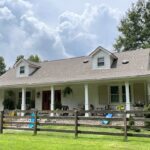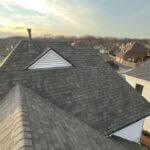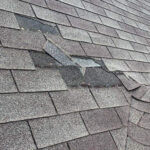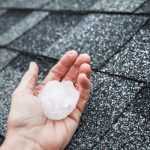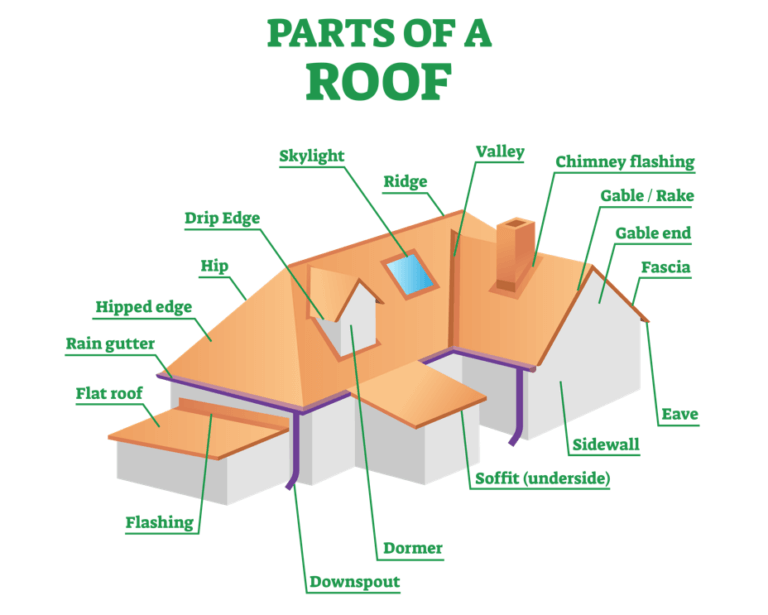
What are The Main Parts of a Roof?
Roofs are more than just an overhead structure; they are a complex system made up of various parts, each playing a critical role in its durability and functionality.
While many might consider a roof to be merely shingles and rafters, our Collierville roofing company would argue otherwise, emphasizing the various elements that come together to offer a complete protective shield. Let’s delve into the anatomy of a roof to understand its components better.
- Shingles: These are perhaps the most visible part of any roof. Shingles can be made of various materials, including asphalt, wood, metal, or tile. They protect your roof from water damage and lend an aesthetic appeal to your home. Periodic inspections ensure their longevity and functionality.
- Underlayment: Think of this as a protective barrier, a secondary shield beneath the shingles. The underlayment is a water-resistant or waterproof material laid on the deck of the roof before installing the shingles. It provides an extra layer of protection from rain and snow.
- Flashing: Located around roof protrusions and intersections, like chimneys, vents, and valleys, flashing is a thin material, typically made of galvanized steel. Its primary purpose is to direct water away from these areas, preventing seepage and leaks.
- Trim: The trim protects the seams of the roof, like those along the hips and ridges. Apart from its protective role, it adds a touch of elegance and aesthetic appeal, completing the look of your roof.
- Rafters and Trusses: Often considered the backbone of the roof, rafters and trusses provide the primary structural support. They hold the weight of the entire roofing system, ensuring its stability.
- Decking (or Sheathing): Laid over the rafters and trusses, decking offers a solid surface where the shingles and underlayment can be installed. Typically made of plywood or oriented strand board (OSB), it serves as the foundation for other roof materials.
- Drip Edge: This is a metal piece that’s installed along the edges of the roof. The drip edge ensures that water is directed away from the fascia and into the gutters, playing a pivotal role in preventing water damage.
- Fascia and Soffits: The fascia is the board running along the edge of the roof, crucial for mounting gutters. Soffits, on the other hand, are located beneath the rafter tails, ensuring adequate ventilation for the attic and protecting the house from pests and moisture.
- Ridge Vent: Positioned along the roof’s peak, the ridge vent ensures the attic remains well-ventilated. It plays a role in maintaining temperature balance, preventing excess heat buildup during summers or condensation during winters.
- Gutters and Downspouts: An often overlooked but essential component, gutters and downspouts effectively direct water away from your home’s foundation. By collecting rainwater and channeling it away, they prevent erosion, water damage, and basement flooding.
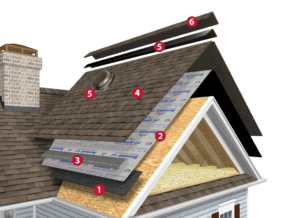
The next time you look at a roof or discuss it with a Collierville roofing company, you’ll appreciate the intricate symphony of parts that harmoniously work together.
A well-maintained roof isn’t just about intact shingles but ensuring that every component, from the underlayment to the ridge vent, functions optimally. Understanding these parts can help homeowners make informed decisions about repairs, replacements, and upgrades, ensuring a roof that stands the test of time and weather.
More Important Roof Terms
Now the you know the main areas of the roof, here’s a breakdown of some of the other components that make up the roof system.
- Rakes and Eaves: At first glance, these terms may seem interchangeable, but they signify different edges of your roof. The rake is the slanting edge of a roof, running at an angle from the eaves to the peak. On the other hand, eaves are the horizontal edges where most homeowners would recognize the placement of gutters. In simpler terms, think of the eaves as the ‘gutter line’.
- Roof Facets: If you’ve ever noticed the various ‘sides’ or sections of a roof, those are referred to as roof facets. Each facet is like a face or plane of the roof.
- Complexity and Facets: Not all roofs are created equal. Some are simple with just a few facets, while others are architectural masterpieces with numerous facets. The greater the intricacy in design, the more facets your roof will possess.
- Roof Valleys and Hips: These are critical components, ensuring water flow and structural integrity. Roof valleys appear when two facets of a roof converge, creating a V-shaped dip where water can be channeled down. In contrast, a hip is the raised angle formed when two facets meet, creating an outward-facing point.
- Gable: Often recognized by its triangular shape, a gable exists where two roof facets slope downwards towards a wall. Beyond its architectural appeal, gables have functional importance, often housing the popular ventilation spot known as the gable end vent.
- Fascia: Situated directly beneath the eaves and rakes, the fascia is more than just an aesthetic finish to the roofline. While it enhances the visual appeal, the fascia plays a pivotal role, acting as a support for gutters and often being the mount for a drip edge.
- Soffit: Located just below the fascia is the soffit, covering the underside where a roof overhangs a wall. Roofers often place intake vents here, making it a crucial component for roof ventilation.
- Dormer: Breaking the monotony of expansive roofs, a dormer protrudes from the primary roof plane, almost like a mini roof within a roof. It usually houses windows and provides architectural interest, ventilation, and additional interior light.
Understanding these terms will not only enhance your appreciation for the architectural beauty above but also equip you with the knowledge needed when conversing with roofing professionals or considering roof modifications.
Work With Restoration Roofing
For all your roofing needs, trust the experts at Restoration Roofing. We’re more than just a Collierville roofing company; we’re your partners in home protection. Contact us today!
Give us a call at 901-854-3402 or fill out our Contact Us form and we will reach out to you with our next available inspection. Make sure to follow us on Facebook and Instagram for more tips on finding the best roofing contractor for you.

